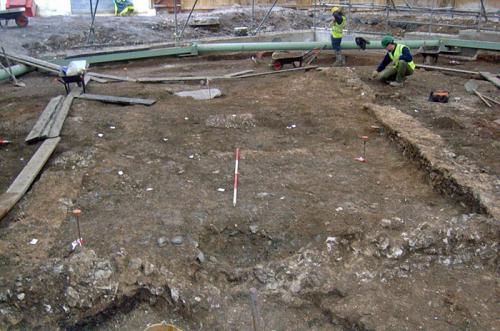Commercial development at 28 Jewry Street is giving us the opportunity to investigate a corner of the city which still holds unanswered questions for archaeologists and historians. Wessex Archaeology Ltd was appointed by Clanfield Properties Ltd to carry out initial test pitting last year. Based on this work an excavation strategy was designed and agreed by Winchester City Council's Heritage Environment Officer. The unusual strategy involved sinking the piled foundations of the new building into the ground before rather than after the excavation. As a result archaeologists can dig right up to the edges of the site and work safely at some depth below the adjacent road and buildings.
Preliminary work started just before Christmas and the excavation began in earnest last Monday, 5th January 2009. The excavation team of ten will be on site until the end of February. By then we expect to have investigated around 300 cubic metres of archaeological deposits ranging in date from the Iron Age right up to the 19th century.
Perhaps the greatest archaeological potential of the site is to give us more evidence about the development of the Late Saxon (AD 9th-10th century) town, in particular its north-western corner. The site lies over the line of a street and buildings that were part of the Late Saxon town plan. Among the questions we would like to answer are when the street was first laid out and how built-up it was.
Below the Late Saxon street and buildings we also expect to find traces of the earlier Roman town. It is likely that a Roman street runs through the site and we may find evidence for its development and that of any buildings that flanked it.
It is possible that evidence of earlier structures or occupation may also survive. The site is inside the Iron Age enclosure of Oram's Arbour, which preceded the Roman town.
As well as the remains of streets and buildings, we expect to recover large quantities of finds and environmental remains. These will tell us more about the activities carried out on the site at the various stages of its history.
Pottery, animal bone, plant and seed remains and industrial residues, such as those produced from metalworking, can give us a picture of people's everyday activities in the past.
The north-western corner of the historic city has been the subject of a number of excavations in recent years and we now have a much better idea of its development through time. The current excavation will add to the results of excavations carried out nearby on Jewry Street and in Staple Gardens.
During the excavation we will be providing information on boards at the site and in the Winchester Discovery Centre opposite.
